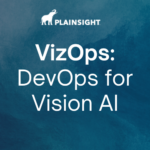In a recent conversation between Kit Merker, CEO of Plainsight Technologies and Larry Carvalho, Principal Consultant at RobustCloud, they delved into the current state of AI, computer vision, and the broader implications of automation on industries ranging from retail to supply chains. This interview, held against the backdrop of a Seattle Seahawks game and an Amazon Web Services (AWS) briefing, Larry and Kit touched on a number of key topics, including the future of retail technology, AI agents, and the financial and ethical challenges surrounding AI adoption.
AWS’s Shift Towards Simplicity in Retail Technology
AWS is making strides in transforming its retail experiences, particularly with Amazon’s “Just Walk Out” technology. This approach has evolved from a reliance on vision-based systems to a hybrid model that incorporates card-based scanning in smaller, high-traffic environments like stadiums and airports. The outcome is a more streamlined customer experience that eliminates larger retail spaces’ complexity and spatial demands.
This shift in strategy highlights how even tech giants like Amazon are willing to experiment and adjust based on what works in practice. For businesses considering implementing similar systems, this iterative approach underscores the importance of flexibility and learning from trial and error.
The Cost Barrier to Widespread AI & Computer Vision Adoption
One of the core challenges facing businesses looking to adopt advanced AI and computer vision technologies is cost. For many industries, from agriculture to mining, the question becomes: how can these technologies deliver tangible business value without breaking the bank?
In retail, for example, the initial investment in computer vision systems (often combined with the hefty cost of GPUs) must be justified by a strong return on investment (ROI). The cost of scaling AI solutions—whether it’s the number of cameras, GPUs, or edge computing systems—can become prohibitive for smaller enterprises.
The Rise of AI Agents: The Next Evolution in Automation
Another hot topic in the conversation was the growing interest in AI agents. AI agents can automate complex business processes by connecting various tasks into a single, streamlined workflow. This evolution—from apps to chatbots to now agents—reflects the ongoing push towards more intelligent, autonomous systems capable of performing tasks without human intervention.
AI agents have the potential to transform industries, from automating customer service workflows in enterprises to enhancing industrial automation in manufacturing. However, the cost vs. simplicity trade-off remains central. Businesses must weigh the value of increased automation against the financial and logistical challenges of implementation.
The fear of job displacement remains a major hurdle in adopting these systems. However, AI should not be viewed as a job-killer but rather as arming their jobs more effectively by eliminating tool that helps employees perform repetitive tasks.
Ethical & Intellectual Property Concerns in AI
A recurring theme in discussions around AI, and particularly in this interview, is the issue of ethics and intellectual property (IP). The lawsuits tech giants like Microsoft have faced over AI training practices, raising the question of how AI models are being trained, and on what data. Ensuring that AI is built on diverse, unbiased datasets is essential to avoid creating systems that perpetuate unfair outcomes.
At the same time, businesses must navigate the challenge of protecting their IP in an increasingly AI-driven world. Who owns the models trained on proprietary data? How do companies ensure their AI tools comply with ethical standards? These questions will only become more pressing as AI continues to advance.
The GPU Problem: Scaling AI Solutions
Another roadblock for AI adoption is the shortage and rising cost of GPUs, the computational engines behind much of AI. Businesses are not only facing supply chain constraints in acquiring GPUs but are also grappling with the sticker shock of implementing large-scale AI systems. The costs can be staggering. In the computer vision space, it’s a simple equation: more cameras and more stores mean more GPUs, which can lead to ballooning costs.
To mitigate these issues, some companies are exploring alternatives like edge inference and optimized CPUs to reduce the reliance on GPUs. While this approach can alleviate some of the cost pressures, it presents its own set of challenges, particularly around the trade-offs between computational power and efficiency.
Conclusion: Navigating the Future of AI & Automation
The conversation between Kit and Larry paints a clear picture: AI and automation hold immense promise, but businesses must carefully navigate the cost, complexity, and ethical concerns involved in their adoption. Whether it’s implementing streamlined retail technologies like Amazon’s “Just Walk Out,” embracing the rise of AI agents or managing the costs of scaling computer vision systems, companies must find the right balance to deliver value without losing sight of the bigger picture.
As industries continue to explore AI’s potential, the key takeaway is clear: flexibility, experimentation, and a focus on delivering real ROI will be critical to success in this rapidly evolving landscape.
Check out the full interview on our YouTube and stay tuned for more insights from Plainsight’s Filter Lab!




